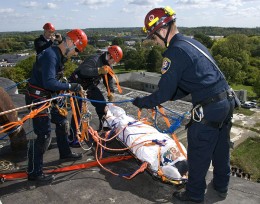
Pararescue jumpers from the Kentucky Air National Guard will train at Wright State’s National Center for Medical Readiness at Calamityville.
Air Force pararescuemen, who recover and treat victims of combat and disasters, will descend upon Calamityville to train and help demonstrate new military technology that combines live and simulated experiences.
The weeklong training session at Wright State University’s National Center for Medical Readiness (NCMR) at Calamityville involves pararescue jumpers, or PJs, from the Kentucky Air National Guard based in Louisville.
Pararescuemen are parachute-jump-qualified trauma specialists who perform life-saving missions in the world’s most remote areas. Units include PJs; combat controllers, who deploy into battle zones to establish assault landing areas or airfields; and special operations weathermen trained to operate in hostile territory.
This event is a technology demonstration for Live, Virtual and Constructive (LVC) training tools and will take place from March 24 to 28. It is jointly hosted by Wright State University and the Air Force Research Laboratory at Wright-Patterson Air Force Base.
The training session, called Fortis Angel, is supported by technologies from Aptima, Ball Aerospace & Technologies Corp., Black River Systems Company, CAE, Cubic Inc., Lumir Research Institute, Real Time Immersive, Inc., and the University of Toledo.
“It is a scenario where they are going to be coming in, rescuing some people, providing medical care and pulling them out of the situation they are in,” said NCMR Director Rufus Smith, a retired Army brigadier general. “This event is to be a technology demonstration that AFRL and their contractors have been working.”
The event will demonstrate LVC integration of technology. LVC combines training capabilities to provide more efficient and effective training opportunities.
“It’s taking live participants and elements of a live event to populate a computer-generated virtual world,” Smith said. “The pararescuemen will be outfitted with sensors during the training so that they can be tracked and then pulled into the virtual world.”
The complete training mission, including both live and virtual training environments, will be recorded and then played back to the trainees to allow for after-action review that has been linked to enhanced learning.
The National Center for Medical Readiness at Calamityville is a 52-acre disaster training zone with concrete passageway-filled buildings, silos, tunnels, ponds, cliffs and wooded areas. It prepares the civilian and military medical communities to work with traditional disaster responders and provides the nation with a more complete approach to finding patients, offering initial care and safely evacuating them from disaster-related environments.

 Milling around
Milling around  Wright State recognizes Nursing Professor Kim Ringo for advancing international student success
Wright State recognizes Nursing Professor Kim Ringo for advancing international student success  Wright State honors graduating students for distinguished doctoral dissertations
Wright State honors graduating students for distinguished doctoral dissertations  Top 10 Newsroom videos of 2025
Top 10 Newsroom videos of 2025  Museum-quality replica of historic Hawthorn Hill donated to Wright State
Museum-quality replica of historic Hawthorn Hill donated to Wright State 